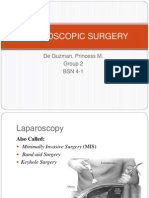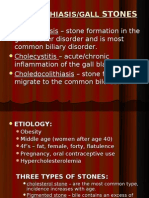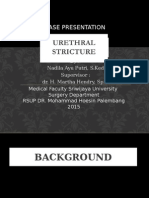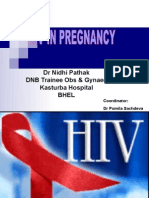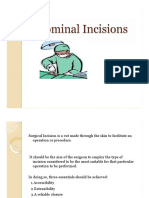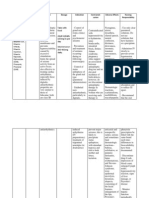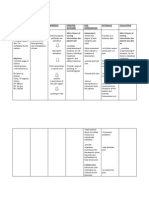Appendectomy
Appendectomy
Uploaded by
Roseben SomidoCopyright:
Available Formats
Appendectomy
Appendectomy
Uploaded by
Roseben SomidoOriginal Description:
Original Title
Copyright
Available Formats
Share this document
Did you find this document useful?
Is this content inappropriate?
Copyright:
Available Formats
Appendectomy
Appendectomy
Uploaded by
Roseben SomidoCopyright:
Available Formats
A laparotomy is a surgical procedure involving a large incision through the abdominal wall to gain access into the abdominal
cavity. It is also known as coeliotomy. Terminology In diagnostic laparotomy (most often referred to as an exploratory laparotomy and abbreviated Ex-Lap), the nature of the disease is unknown, and laparotomy is deemed the best way to identify the cause. In therapeutic laparotomy, a cause has been identified (e.g. peptic ulcer, colon cancer) and laparotomy is required for its therapy. Usually, only exploratory laparotomy is considered a stand-alone surgical operation. When a specific operation is already planned, laparotomy is considered merely the first step of the procedure. Spaces accessed Depending on incision placement, laparotomy may give access to any abdominal organ or space, and is the first step in any major diagnostic or therapeutic surgical procedure of these organs, which include:
the lower part of the digestive tract (the stomach, duodenum, jejunum, ileum and colon) the liver, pancreas and spleen the bladder the female reproductive organs (the uterus and ovaries) the retroperitoneum (the kidneys, the aorta, abdominal lymph nodes) the appendix
Types of incisions Midline The most common incision for laparotomy is the midline incision, a vertical incision which follows the lineaalba.
The upper midline incision usually extends from the xiphoid process to the umbilicus. A typical lower midline incision is limited by the umbilicus superiorly and by the pubic symphysis inferiorly.
Sometimes a single incision extending from xiphoid process to pubic symphysis is employed, especially in trauma surgery.
Midline incisions are particularly favoured in diagnostic laparotomy, as they allow wide access to most of the abdominal cavity. Other Other common laparotomy incisions include: TheKocher (right subcostal) incision (after Emil Theodor Kocher); appropriate for certain operations on the liver, gallbladder and biliary tract. This shares a name with the Kocher incision used for thyroid surgery: a transverse, slightly curved incision about 2 cm above the sternoclavicular joints; the Davis or Rockey-Davis "muscle-splitting" right lower quadrant incision for appendectomy; the Pfannenstiel incision, a transverse incision below the umbilicus and just above the pubic symphysis. In the classic Pfannenstiel incision, the skin and subcutaneous tissue are incised transversally, but the lineaalba is opened vertically. It is the incision of choice for Cesarean section and for abdominal hysterectomy for benign disease. A variation of this incision is the Maylard incision in which the rectus abdominis muscles are sectioned transversally to permit wider access to the pelvis.
Lumbotomy consists of a lumbar incision which permits access to the kidneys (which are retroperitoneal) without entering the peritoneal cavity. It is typically used only for benign renal lesions. It has also been proposed for surgery of the upper urological tract. Related procedures A related procedure is laparoscopy, where cameras and other instruments are inserted into the peritoneal cavity via small holes in the abdomen. For example, an appendectomy can be done either by a laparotomy or by a laparoscopic approach.
An appendectomy (sometimes called appendisectomy or appendicectomy) is the surgical removal of the vermiform appendix. This procedure is normally performed as an emergency procedure, when the patient is suffering from acute appendicitis. In the absence of surgical facilities, intravenous antibiotics are used to delay or avoid the onset of sepsis; it is now recognized that many cases will resolve when treated perioperatively. In some cases the appendicitis resolves completely; more often, an inflammatory mass forms around the appendix, causing transruptural flotation. This is a relative contraindication to surgery. Appendectomy may be performed laparoscopically (this is called minimally invasive surgery) or as an open operation. Laparoscopy is often used if the diagnosis is in doubt, or if it is desirable to hide the scars in the umbilicus or in the pubic hair line. Recovery may be a little quicker with laparoscopic surgery; the procedure is more expensive and resource-intensive than open surgery and generally takes a little longer, with the (low in most patients) additional risks associated with pneumoperitoneum (inflating the abdomen with gas). Advanced pelvic sepsis occasionally requires a lower midline laparotomy. There have been some cases of auto-appendectomies, i.e. operating on yourself. One was performed by Dr Kane in 1921, but the operation was completed by his assistants. Another case is Leonid Rogozov who had to perform the operation on himself as he was the only surgeon on a remote Arctic base.
Procedure
In general terms, the procedure for an open appendectomy is as follows. 1. Antibiotics are given immediately if there are signs of sepsis, otherwise a single dose of prophylactic intravenous antibiotics is given immediately prior to surgery. 2. General anaesthesia is induced, with endotracheal intubation and full muscle relaxation, and the patient is positioned supine. 3. The abdomen is prepared and draped and is examined under anesthesia.
4. If a mass is present, the incision is made over the mass; otherwise, the incision is made over McBurney's point, one third of the way from the anterior superior iliac spine (ASIS) and the umbilicus; this represents the position of the base of the appendix (the position of the tip is variable). 5. The various layers of the abdominal wall are then opened. 6. The effort is always to preserve the integrity of abdominal wall. Therefore, the External Oblique Aponeurosis is slitted along its fiber, and the internal oblique muscle is split along its length, not cut. As the two run at right angles to each other, this prevents later Incisional hernia. 7. On entering the peritoneum, the appendix is identified, mobilized and then ligated and divided at its base. 8. Some surgeons choose to bury the stump of the appendix by inverting it so it points into the caecum. 9. Each layer of the abdominal wall is then closed in turn. 10. The skin may be closed with staples or stitches. 11. The wound is dressed. 12. The patient will be brought to the recovery room.
NURSING MANAGEMENT: Assess the severity and location of pain. If client presents with board-like rigidity and severe pain, suspect for peritonitis. Administer analgesics after a diagnosis is made. Assess the effectiveness of the analgesic given. Position client in a supine position with thighs slightly flexed.
Preoperative care It is important to prepare a patient several hours pre-surgery. The patient may be dehydrated due to symptoms such as vomiting. It may be necessary to administer IV fluids. The patient's vital signs should be recorded every 2-4 hours. The nurse should not apply any heat over the area of pain while the patient is awaiting diagnosis as this could cause the appendix to rupture (Box 2). Analgesia should not be administered before examination because this can lead to an inaccurate diagnosis as the pain may subside and the examination will be ineffective. Aperients should also be avoided as induced peristalsis may cause perforation. If appendicitis has been diagnosed regular analgesia, usually an opioid depending on pain severity, should be given to make the patient comfortable before treatment. They may feel anxious so the nurse or surgical team should fully explain the procedure to them and answer any questions. The operation site will be washed and shaved before surgery, depending on local procedures. Postoperative care The severity of the patient's pain needs to be assessed with the use of a pain scale. Appropriate pain relief can then be administered. Vital signs should be regularly monitored at half-hourly intervals for two hours postoperatively, hourly for two hours and, if stable, every four hours while the patient is recovering in hospital. If the patient has had a straightforward appendectomy the surgical team should review the patient on recovery and decide when they may eat and drink. A drain may have been inserted during surgery. If so, the output of the drain should be recorded every 24 hours. The drain can be removed when there is minimal drainage - usually 50ml or less. The wound should be managed aseptically. If the wound is covered with a dry dressing then it should be changed every 1-2 days. Clips/stitches should be removed 10 days postoperatively. The patient can go home with these in place and the district or practice nurse can remove them. If dissolvable stitches have been used this is unnecessary, although a visit to check the wound will reduce anxiety. Before discharge, the patient must be confident in how to manage their wound and have details of who they should contact in case of concern. The patient should be encouraged to get up and out of bed as soon as possible to prevent the formation of emboli. Anticoagulants are usually administered in the form of subcutaneous injections before surgery and postoperatively. Antiembolism stockings should be worn. If peritonitis has developed, the patient's postoperative management will be over a longer period but will follow the same principles. The patient will not be able to commence food and fluids for a few days, this is to enable the bowel to regain normal function. The convalescence period is almost invariably smooth and the patient recovers rapidly (Colmer, 1986). The hospital stay for patients who have undergone an uncomplicated appendectomy is usually 2-3 days. In most cases the patient will be discharged when their temperature is normal and their bowels have started to function again (Peterson, 2002). People can live a full life without their appendix. Changes in diet, exercise or other lifestyle factors are not necessary (NDDIC, 2004).
You might also like
- Nur 205 1 Exam 1 Study GuideDocument10 pagesNur 205 1 Exam 1 Study Guidesylphlike5No ratings yet
- Case Presentation Scripts For Morning Meeting 1Document3 pagesCase Presentation Scripts For Morning Meeting 1Jam Knows RightNo ratings yet
- Exploratory LaparotomyDocument13 pagesExploratory LaparotomyCj Atto100% (1)
- Palatoplasty Case StudyDocument26 pagesPalatoplasty Case StudySometwo C. Hangal100% (1)
- Ewing's SarcomaDocument16 pagesEwing's SarcomaChacha Zakiya100% (1)
- Pa Tho Physiology of Ectopic PregnancyDocument2 pagesPa Tho Physiology of Ectopic Pregnancythediaber60% (5)
- Case Study On Typhoid FeverDocument34 pagesCase Study On Typhoid FeverRoseben SomidoNo ratings yet
- Training Needs AnalysisDocument44 pagesTraining Needs AnalysisJessuel Larn-eps100% (2)
- AppendectomyDocument35 pagesAppendectomyleighjagNo ratings yet
- Total Abdominal Hysterectomy Bilateral SaphingoDocument7 pagesTotal Abdominal Hysterectomy Bilateral SaphingoAndrea BroccoliNo ratings yet
- Exploratory LaparotomyDocument24 pagesExploratory Laparotomyyynu_sia48475No ratings yet
- Gastric Outlet Obstruction, A Simple Guide To The Condition, Diagnosis, Treatment And Related ConditionsFrom EverandGastric Outlet Obstruction, A Simple Guide To The Condition, Diagnosis, Treatment And Related ConditionsNo ratings yet
- Laparoscopic SurgeryDocument16 pagesLaparoscopic Surgeryprincess-mendoza-de-guzman-808No ratings yet
- Appendicitis: I. Signs and SymptomsDocument3 pagesAppendicitis: I. Signs and Symptomsslimescared01No ratings yet
- CholelithiasisDocument37 pagesCholelithiasisbaby padzNo ratings yet
- MastectomyDocument6 pagesMastectomyJustinAlmedaNo ratings yet
- 1101201903.pelvic Inflammatory DiseaseDocument34 pages1101201903.pelvic Inflammatory Diseaseraed faisalNo ratings yet
- AppendectomyDocument5 pagesAppendectomyCris EstoniloNo ratings yet
- CholecystectomyDocument5 pagesCholecystectomyRachelle Maderazo CartinNo ratings yet
- Complication of Peptic Ulcer: Department of Surgery S. S. Medical College Rewa and Associate GMH and SGMH RewaDocument76 pagesComplication of Peptic Ulcer: Department of Surgery S. S. Medical College Rewa and Associate GMH and SGMH RewaBrajesh MouryaNo ratings yet
- Abdominal InjuryDocument92 pagesAbdominal InjurympalanethraNo ratings yet
- Mastectomy: Prepared By: Hilario, Eunice Lamoste, Jenebelle Lopez, Maria SofiaDocument34 pagesMastectomy: Prepared By: Hilario, Eunice Lamoste, Jenebelle Lopez, Maria SofiaSofia LopezNo ratings yet
- Check List Suturing Aseptik - Revisi 19-01-10Document4 pagesCheck List Suturing Aseptik - Revisi 19-01-10Arief Yunan PriyoutomoNo ratings yet
- Urethral StrictureDocument43 pagesUrethral StrictureNadila Ayu Putri50% (2)
- Penetrating Abdominal Trauma Emergency ManagementDocument29 pagesPenetrating Abdominal Trauma Emergency Managementanjali singhNo ratings yet
- Tuberculosis Case StudyDocument43 pagesTuberculosis Case StudyAJIgama100% (1)
- Prostate CancerDocument19 pagesProstate CancersamwelNo ratings yet
- Blunt Trauma AbdomenDocument41 pagesBlunt Trauma AbdomenSanthanu SukumaranNo ratings yet
- Nursing Diagnosis For Lower Respiratory DiseasesDocument5 pagesNursing Diagnosis For Lower Respiratory Diseasesngoto8867% (3)
- MASTOIDECTOMY Written OutputDocument3 pagesMASTOIDECTOMY Written OutputJoe RealNo ratings yet
- Stomach Peptic UlcerDocument38 pagesStomach Peptic UlcermohamedNo ratings yet
- SurgeryDocument98 pagesSurgeryinchack50% (2)
- Case Study MastectomyDocument26 pagesCase Study MastectomyIcheAnne Nilay100% (3)
- Vaginal Birth After Previous Caesarean SectionDocument26 pagesVaginal Birth After Previous Caesarean SectionWonyenghitari George100% (1)
- Meconium Stained LiquorDocument4 pagesMeconium Stained LiquorYwagar Ywagar100% (1)
- LaparotomyDocument36 pagesLaparotomydenekeNo ratings yet
- Notes HemorrhoidsDocument4 pagesNotes HemorrhoidsSanthu Su100% (1)
- Cervical IncompetenceDocument30 pagesCervical IncompetenceSignor ArasNo ratings yet
- Chest TraumaDocument25 pagesChest Traumadrpravalk100% (1)
- Basic Principles of Surgery: DEVELOPING A SURGICAL DIAGNOSIS: Important DecisionsDocument5 pagesBasic Principles of Surgery: DEVELOPING A SURGICAL DIAGNOSIS: Important DecisionsStudent FemNo ratings yet
- IV Medication Check-ListDocument7 pagesIV Medication Check-Listhewmour android100% (1)
- Extrahepatic Biliary Tract Pathology - Cholidolithiasis, Cholidocholithiasis, Cholecystitis and CholangitisDocument60 pagesExtrahepatic Biliary Tract Pathology - Cholidolithiasis, Cholidocholithiasis, Cholecystitis and CholangitisDarien LiewNo ratings yet
- PYOMYOSITISDocument12 pagesPYOMYOSITISJeg B. Israel Jr.No ratings yet
- Mastectomy (Case Analysis)Document7 pagesMastectomy (Case Analysis)Lester_Ocuaman_2248No ratings yet
- Upper Gastrointestinal BleedingDocument69 pagesUpper Gastrointestinal Bleedingeliza luisNo ratings yet
- Acutescrotum 141125014842 Conversion Gate01Document18 pagesAcutescrotum 141125014842 Conversion Gate01Keserovic AdmirNo ratings yet
- Liver CancerDocument2 pagesLiver CancerPrincess Barnuevo100% (2)
- PPH by Dr. Rajabu Nyangara MtillyDocument38 pagesPPH by Dr. Rajabu Nyangara MtillynyangaraNo ratings yet
- Compartment SyndromeDocument3 pagesCompartment SyndromeTantyo Adi P100% (2)
- A. Antineoplastic DrugsDocument48 pagesA. Antineoplastic DrugsKim Shyen BontuyanNo ratings yet
- The Incompetent Cervix 2Document30 pagesThe Incompetent Cervix 2api-3705046100% (3)
- Hiv in Pregnancy FinalDocument73 pagesHiv in Pregnancy Finalapi-3797079No ratings yet
- Final EditDocument43 pagesFinal EditMary Rose LinatocNo ratings yet
- Clavicle FractureDocument33 pagesClavicle FractureNitin AggarwalNo ratings yet
- Peritoneal Carcinomatosis Grand Case StudyDocument69 pagesPeritoneal Carcinomatosis Grand Case StudyBeverly Joy RubiNo ratings yet
- Laryngeal Cancer Powerpoint FinalllllDocument30 pagesLaryngeal Cancer Powerpoint Finalllllapi-396575125No ratings yet
- HerniaDocument11 pagesHerniaHapsari Wibawani 'winda'100% (1)
- Nursing Care Plan For Inguinal HerniaDocument1 pageNursing Care Plan For Inguinal HerniaYvonne Joyce Gayagoy GomezNo ratings yet
- Insisi Bedah 22 PDFDocument36 pagesInsisi Bedah 22 PDFMiftah AjiNo ratings yet
- Hydatidiform Mole Study GuideDocument4 pagesHydatidiform Mole Study GuideCarl Elexer Cuyugan AnoNo ratings yet
- Western Mindanao State University College of Nursing Zamboanga CityDocument4 pagesWestern Mindanao State University College of Nursing Zamboanga CityEzra LambarteNo ratings yet
- Ventricular Septal Defect, A Simple Guide To The Condition, Treatment And Related ConditionsFrom EverandVentricular Septal Defect, A Simple Guide To The Condition, Treatment And Related ConditionsNo ratings yet
- A Simple Guide to Abdominal Aortic Aneurysm, Diagnosis, Treatment and Related ConditionsFrom EverandA Simple Guide to Abdominal Aortic Aneurysm, Diagnosis, Treatment and Related ConditionsNo ratings yet
- Hirschsprung’s Disease, A Simple Guide To The Condition, Diagnosis, Treatment And Related ConditionsFrom EverandHirschsprung’s Disease, A Simple Guide To The Condition, Diagnosis, Treatment And Related ConditionsNo ratings yet
- Funda Q and ADocument4 pagesFunda Q and ARoseben SomidoNo ratings yet
- MethergineDocument2 pagesMethergineRoseben SomidoNo ratings yet
- Impaired Physical MobilityDocument2 pagesImpaired Physical MobilityRoseben SomidoNo ratings yet
- Pregabalin Drug by IvanDocument3 pagesPregabalin Drug by IvanRoseben Somido100% (1)
- Ferrous SulfateDocument2 pagesFerrous SulfateRoseben SomidoNo ratings yet
- PhynetoinDocument3 pagesPhynetoinRoseben SomidoNo ratings yet
- NLE Reviewer Q and ADocument11 pagesNLE Reviewer Q and ARoseben Somido100% (1)
- NCP ConstipationDocument2 pagesNCP ConstipationRoseben Somido100% (1)
- NCP - Disturbed Body ImageDocument3 pagesNCP - Disturbed Body ImageRoseben Somido100% (1)
- Roseben R. Somido: PATIENT: Mitra Michelle, 8 Years Old CASE: Enteric FeverDocument2 pagesRoseben R. Somido: PATIENT: Mitra Michelle, 8 Years Old CASE: Enteric FeverRoseben SomidoNo ratings yet
- Drug Study - Paracetamol Ambroxol, Ascorbic Acid, CefuroximeDocument4 pagesDrug Study - Paracetamol Ambroxol, Ascorbic Acid, Cefuroximeapi-3701489100% (12)
- Roseben R. Somido: PATIENT: Delos Reyes, Lloyd: 2mos - Old CASE: Pneumonia SevereDocument2 pagesRoseben R. Somido: PATIENT: Delos Reyes, Lloyd: 2mos - Old CASE: Pneumonia SevereRoseben SomidoNo ratings yet
- Wound DebridementDocument3 pagesWound DebridementRoseben SomidoNo ratings yet
- DKADocument5 pagesDKARoseben SomidoNo ratings yet
- Altered Cerebral PerfusionDocument3 pagesAltered Cerebral PerfusionRoseben SomidoNo ratings yet
- School Age ChildDocument26 pagesSchool Age ChildRoseben SomidoNo ratings yet
- NCP Hypertension 2Document3 pagesNCP Hypertension 2Roseben Somido50% (2)
- Discharge PlanningDocument1 pageDischarge PlanningRoseben SomidoNo ratings yet
- Preschooler: From 3-5 Years OldDocument44 pagesPreschooler: From 3-5 Years OldRoseben Somido100% (2)
- Vulvitis Power Point NewDocument22 pagesVulvitis Power Point NewRoseben Somido75% (4)
- Nsg. EntrepreneurshipDocument30 pagesNsg. EntrepreneurshipRoseben SomidoNo ratings yet
- Vulvitis Power Point NewDocument22 pagesVulvitis Power Point NewRoseben Somido75% (4)
- NSG MNGTDocument1 pageNSG MNGTRoseben SomidoNo ratings yet
- LAbsDocument7 pagesLAbsRoseben SomidoNo ratings yet
- Generic Name and Brand Name Classification Action Dosage Indication Contraindication Adverse Reaction Nursing ResponsibilityDocument2 pagesGeneric Name and Brand Name Classification Action Dosage Indication Contraindication Adverse Reaction Nursing ResponsibilityRoseben SomidoNo ratings yet
- NaCl Drug StudyDocument2 pagesNaCl Drug StudyRoseben Somido100% (6)
- Roseben R. Somido: PATIENT: Mitra Michelle, 8 Years Old CASE: Enteric FeverDocument2 pagesRoseben R. Somido: PATIENT: Mitra Michelle, 8 Years Old CASE: Enteric FeverRoseben SomidoNo ratings yet
- Diagnostic/La Boratory Procedures/T Ests Purposes Result Analysis and InterpretationDocument1 pageDiagnostic/La Boratory Procedures/T Ests Purposes Result Analysis and InterpretationRoseben SomidoNo ratings yet
- The Social Exchange Final Paper 1Document5 pagesThe Social Exchange Final Paper 1api-255569150No ratings yet
- Vda de Manalo V CADocument5 pagesVda de Manalo V CAJayNo ratings yet
- Villaflores V LimosDocument13 pagesVillaflores V LimosJenicaNo ratings yet
- Chapter 3 Internet Homework ProblemsDocument3 pagesChapter 3 Internet Homework ProblemsSnehanshu SumanNo ratings yet
- Chp. 24, Origin of Species1Document86 pagesChp. 24, Origin of Species1zoology qauNo ratings yet
- Lifting The Corporate VeilDocument21 pagesLifting The Corporate VeilPrakhar BhandariNo ratings yet
- ChatGPT Prompts For Thesis WritingDocument6 pagesChatGPT Prompts For Thesis WritingGilang Samudra100% (1)
- Gravity, Blood Circulation, and The Adaptation of and Function in Lower VertebratesDocument9 pagesGravity, Blood Circulation, and The Adaptation of and Function in Lower VertebratesGennaro Jr Di NapoliNo ratings yet
- Diagnostics InformationDocument8 pagesDiagnostics InformationJuan Carlos Peña ShapiamaNo ratings yet
- Nature of DanceDocument3 pagesNature of DanceJerald TalimudaoNo ratings yet
- Counted With The StarsDocument35 pagesCounted With The StarsBethany House PublishersNo ratings yet
- Consent For Assesment and TreatmentDocument2 pagesConsent For Assesment and TreatmentBrooke RobertsNo ratings yet
- Fiitjee Package Questions PDFDocument285 pagesFiitjee Package Questions PDFBharadwaj Subramaniam100% (1)
- Introduction To Language & Linguistics I: Miza Rahmatika Aini, M.ADocument64 pagesIntroduction To Language & Linguistics I: Miza Rahmatika Aini, M.AWinda SaskianaNo ratings yet
- Analysing Short Prose Extracts - Useful Tips For IB English Paper 1Document2 pagesAnalysing Short Prose Extracts - Useful Tips For IB English Paper 1Yazan ZamelNo ratings yet
- Eee Syllabus PDFDocument155 pagesEee Syllabus PDFanunilaNo ratings yet
- Ise Ii Conversation QuestionsDocument5 pagesIse Ii Conversation QuestionsHillary HernandezNo ratings yet
- United States v. Lewis, A.F.C.C.A. (2014)Document13 pagesUnited States v. Lewis, A.F.C.C.A. (2014)Scribd Government DocsNo ratings yet
- Trick To Remember Salt Water Lakes of Rajasthan - GK TricksDocument3 pagesTrick To Remember Salt Water Lakes of Rajasthan - GK TricksJAMESJANUSGENIUS5678100% (1)
- Kirsten Glanvill's ResumeDocument1 pageKirsten Glanvill's ResumeKirsten GlanvillNo ratings yet
- 10 1 1 739 4536Document194 pages10 1 1 739 4536Arun AgnNo ratings yet
- Describing Events GRASPS Unit 4: Applications of ProbabilityDocument5 pagesDescribing Events GRASPS Unit 4: Applications of Probabilitybobburns215No ratings yet
- Marking Scheme - Hiv TDH1100Document4 pagesMarking Scheme - Hiv TDH1100Florence AmaniNo ratings yet
- Guerilla MarketingDocument52 pagesGuerilla MarketingDEEPALI SINGHNo ratings yet
- 6.b. RGP Toric Lens DesignDocument4 pages6.b. RGP Toric Lens Designblack00swanNo ratings yet
- Team Building Proposal - Purple Antz Events v5.3Document10 pagesTeam Building Proposal - Purple Antz Events v5.3NurQaseh AmaniNo ratings yet
- MMW - Correlation AnalysisDocument5 pagesMMW - Correlation AnalysisAliana CorralNo ratings yet
- Proper PositioningDocument13 pagesProper PositioningAbriann Vince ImpenioNo ratings yet












